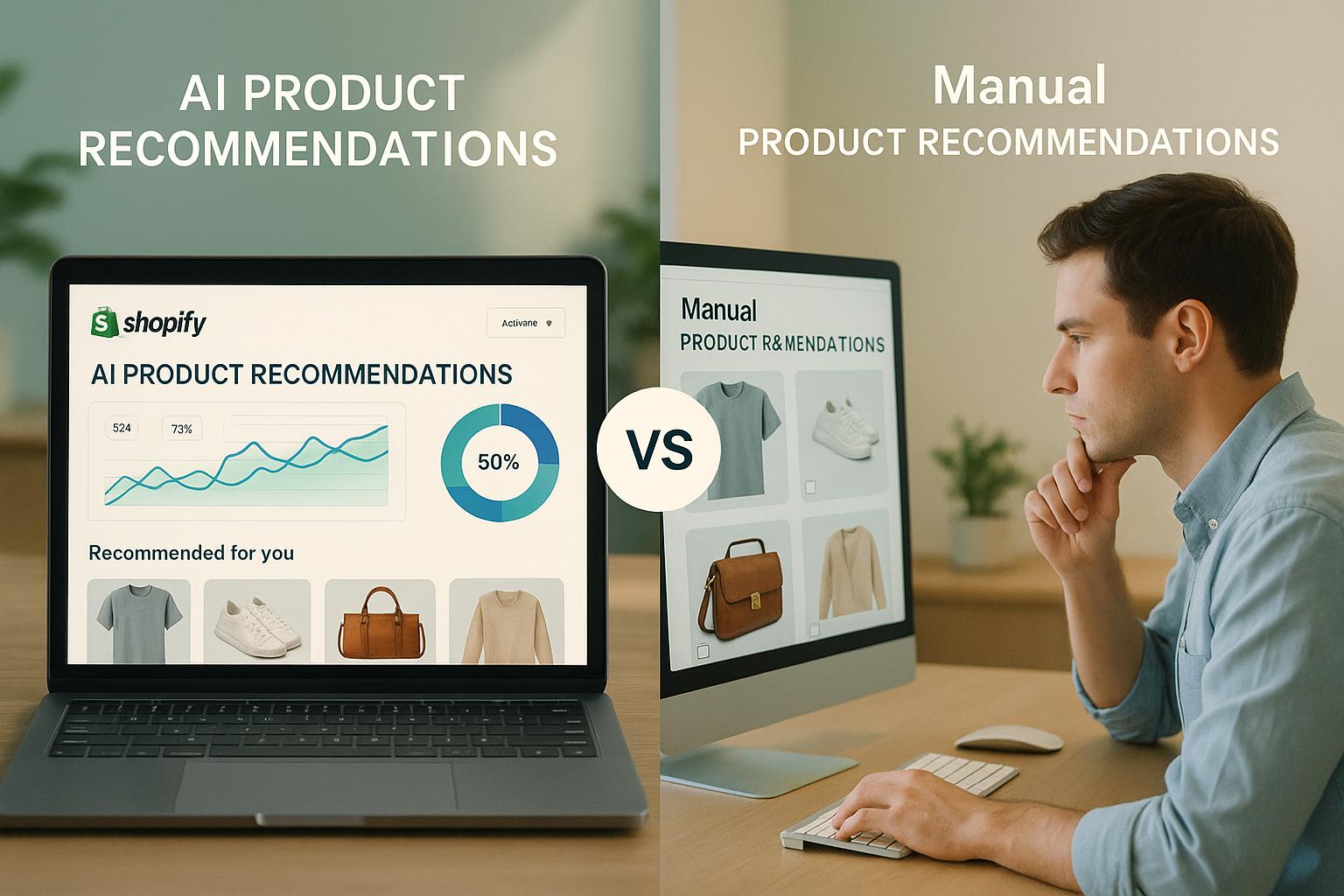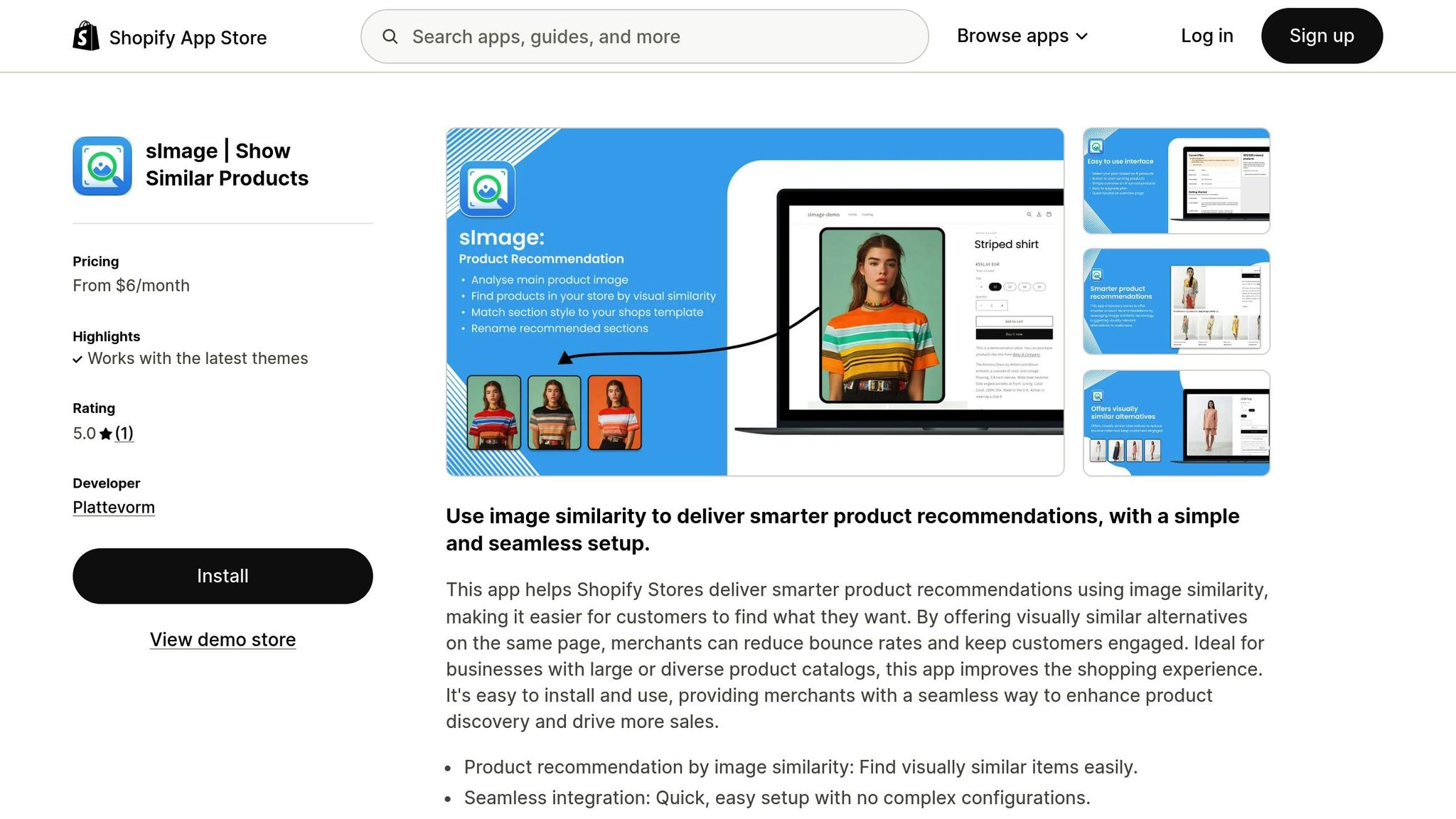AI vs. Manual Product Recommendations on Shopify

AI vs. Manual Product Recommendations on Shopify
When deciding how to recommend products on Shopify, the choice boils down to AI-powered systems or manual methods. Here's the gist:
- AI-powered recommendations use machine learning to analyze customer behavior in real time, offering tailored suggestions. They’re efficient, scalable, and can boost sales by up to 30%.
- Manual recommendations rely on human expertise to curate product pairings. They’re better for small catalogs or niche markets but are time-intensive and harder to scale.
Key Takeaways:
- AI is ideal for stores with large inventories or frequent updates.
- Manual methods work well for small, curated catalogs or specialized products.
- Tools like sImage simplify AI integration on Shopify, offering plans starting at $6/month.
Quick Comparison:
| Factor | AI Recommendations | Manual Recommendations |
|---|---|---|
| Setup Time | Quick integration | Time-intensive |
| Personalization | Real-time adjustments | Broad assumptions |
| Scalability | Handles large catalogs | Struggles with growth |
| Maintenance | Minimal upkeep | Requires constant updates |
For most Shopify stores, AI tools provide a more efficient and data-driven approach to boosting sales and improving customer experience.
How AI Product Recommendations Increase Sales on Shopify

AI-Powered Product Recommendations on Shopify
AI-driven product recommendations have transformed how businesses suggest products to their customers, offering a faster and more personalized approach compared to manual methods. These advanced systems rely on algorithms to analyze customer behavior and preferences, delivering tailored suggestions in real time.
How AI Works in Product Recommendations
AI systems pull insights from customer data - like browsing habits, purchase history, and demographics. Using techniques such as collaborative and content-based filtering, these systems continuously refine their recommendations, ensuring they become more accurate and relevant over time.
Key Benefits of AI-Powered Recommendations
The impact of AI in product recommendations is impressive. Businesses see an average 22.66% boost in conversion rates, a sales increase of up to 30%, and a 25% improvement in customer satisfaction. AI systems also excel at scaling efficiently, quickly adapting to changing trends, and identifying upselling opportunities that can increase revenue by 10–30%.
Integration with Shopify: The Role of sImage

Shopify users can tap into these benefits through tools like the sImage app, which leverages AI-powered image analysis to enhance cross-selling opportunities. By analyzing product images, sImage suggests visually similar items available in the store, improving the shopping experience and encouraging additional purchases.
Here’s how it works: sImage converts product images into vector representations, enabling rapid comparisons to identify similar products. A real-world example comes from The Dutch Tile Project, which reported in December 2024 that sImage's "similar items by image" feature significantly reduced bounce rates while increasing sales through upselling and cross-selling.
What’s more, sImage is easy to integrate with any Shopify theme. It requires no coding for setup and automatically updates with new products added via the Shopify dashboard, making it a hassle-free solution for store owners looking to enhance their customers' shopping journey.
Manual Product Recommendations on Shopify
While AI-driven tools offer impressive automation, many Shopify merchants still stick to the hands-on approach of manual product recommendations. This method gives merchants full control over their suggestions but comes at the cost of time and scalability.
How Manual Recommendations Work
Manual product recommendations involve hand-selecting products to display as related or complementary items on product pages. Merchants carefully analyze their inventory to create logical pairings, often grouping products by category, price range, or how they’re used together. For instance, a clothing store might suggest pairing a dress with a matching handbag, while a home goods retailer could bundle a coffee maker with a set of mugs.
These recommendations aren’t static - they need constant updates. As inventory shifts, trends change, or new items are added, merchants have to refresh their suggestions regularly to keep them relevant.
One example of manual recommendations in action comes from Tushy. In 2023, the company moved most of its product recommendations from pre-purchase pages to thank-you pages. This strategic adjustment led to a 2.6% conversion rate and brought in nearly $200,000 in additional monthly revenue.
Although manual recommendations allow for precise control, they demand ongoing effort and lack the flexibility of automated solutions.
Challenges and Limitations of Manual Recommendations
Manual recommendations become increasingly challenging as a store’s inventory grows. Each pairing has to be individually selected, tested, and updated, making the process incredibly time-consuming and inefficient for larger catalogs.
Another drawback is the inability to quickly react to changes in customer behavior or emerging trends. Unlike AI-powered systems, manual methods struggle to deliver personalized recommendations at scale or adapt to evolving preferences in real time.
It’s worth noting that the recommendation engine market is expected to hit $15.13 billion by 2026. In contrast, manual methods often overlook lesser-known products, potentially limiting a store’s overall revenue opportunities.
sbb-itb-521eef9
Efficiency, Accuracy, and Sales Impact: AI vs Manual Recommendations
Let’s break down how AI-powered recommendations stack up against manual methods when it comes to setup, personalization, and scalability.
Setup Time:
AI-powered systems can be integrated quickly and seamlessly using tools like Shopify Admin. On the other hand, manual recommendations require extensive planning and constant updates, which can become overwhelming as your product catalog grows.
Personalization Depth:
AI thrives on real-time data, offering personalized recommendations tailored to individual customer behavior. Manual methods, however, rely on broad assumptions, often missing the mark when it comes to dynamic, customer-specific adjustments.
Adaptability and Maintenance:
AI systems shine in their ability to adapt automatically to changes like seasonal trends or inventory updates, reducing the need for constant oversight. Manual systems, in contrast, demand ongoing attention and adjustments to stay relevant, which can quickly become a time drain.
Comparison Table: AI vs Manual Recommendations
Here’s a quick look at how the two approaches differ:
| Factor | AI-Powered Recommendations | Manual Recommendations |
|---|---|---|
| Setup Time | Fast integration via Shopify Admin | Time-consuming planning and setup |
| Personalization | Real-time, dynamic adjustments | Broad, static assumptions |
| Scalability | Effortlessly scales with catalog growth | Increasingly difficult with larger catalogs |
| Maintenance | Minimal upkeep thanks to automation | Requires frequent manual updates |
AI-powered recommendations clearly offer a more efficient and scalable solution, especially as your catalog expands. While manual recommendations give you full control over product pairings, their static approach can struggle to keep up in a fast-paced market.
Next, let’s dive into which option might be the best fit for your store’s unique needs.
Choosing the Right Approach for Your Shopify Store
Deciding how to manage product recommendations in your Shopify store is a critical step. Whether you opt for AI-powered tools or stick with manual methods, your choice should align with your store's catalog size and customer behavior. This decision doesn’t just affect operational workflows - it also shapes customer engagement and can drive revenue growth, as discussed earlier.
When to Choose AI-Powered Recommendations
AI-powered recommendations are a natural fit for growing businesses. If your store has a large catalog - think hundreds or thousands of SKUs - or experiences heavy traffic, AI systems can handle the complexity that manual methods simply can’t match. These tools excel at managing real-time personalization and analyzing vast amounts of product and customer data.
Here’s why AI might be the right choice:
- Stores leveraging personalized recommendations often see conversion rates increase by up to 4.5x, with these recommendations contributing to 31% of eCommerce revenue.
- Nearly half (49%) of customers have purchased items they didn’t initially plan to buy after receiving personalized suggestions.
- AI thrives in dynamic environments, such as stores with frequent inventory updates, seasonal promotions, or shifting customer preferences.
Even smaller stores can benefit from lightweight AI tools that are affordable and easy to integrate. For example, Amazon has seen a 25% boost in conversion rates thanks to its AI-driven recommendation engine. Whether your store is big or small, AI can adapt to your needs - making it a versatile option for many Shopify retailers.
When Manual Recommendations May Be Suitable
Manual recommendations still hold value in certain cases, especially for stores with smaller, curated catalogs. For boutique shops or niche markets - like those selling vintage collectibles or professional-grade art supplies - manual methods may align better with the brand’s personalized touch and vision.
Here’s when manual methods might work best:
- For stores with limited product ranges, rule-based systems can effectively pair items or test combinations.
- In niche markets, manual recommendations often resonate more with customers seeking specialized products.
- These methods can also lead to a 15% higher satisfaction rate in complex, interaction-heavy scenarios.
While manual approaches work well for smaller catalogs, they may struggle to scale. For broader product selections, AI tools like sImage offer a more efficient alternative.
How sImage Simplifies AI-Powered Recommendations
sImage makes it easy for Shopify store owners to implement AI-powered recommendations. By analyzing product images, sImage suggests visually similar items available in your store, creating seamless cross-selling opportunities and enhancing the shopping experience.
Here’s what sImage offers:
- Plans that scale with your needs, from a free option for up to 100 products to a $60/month plan for up to 8,000 products, plus custom enterprise solutions.
- A focus on visual similarity, making it ideal for fashion, home decor, and lifestyle products where aesthetics are key.
"AI-powered product recommendations are a game-changer for Shopify stores. They act like a smart sales assistant, showing customers products they're likely to consider." - Manthan Bhavsar
Unlike traditional methods that rely on categories or tags, sImage uncovers connections through image analysis, revealing product relationships that might otherwise go unnoticed. The system also learns from customer interactions, continuously refining its recommendations as your store evolves. For Shopify merchants, this means smarter, more tailored suggestions that grow alongside your business.
Conclusion
Deciding between AI-powered and manual product recommendations for your Shopify store comes down to factors like scalability, efficiency, and your goals for revenue growth. AI-driven systems have proven to outperform manual methods, with recommendation engines significantly boosting revenue across ecommerce platforms.
AI-powered tools excel at delivering personalized suggestions at scale, adapting instantly to customer behavior, and providing measurable returns. For instance, personalized recommendations can increase sales by 1% to 2% and improve profit margins by 1% to 3%. In fact, active personalization can amplify ROI by as much as 2.3 times.
As digital marketing expert Pawel Lawrowski puts it:
"If you're looking to offer personalized experiences and scale your ecommerce business, AI-based recommendations are the way to go. While they may require a larger investment, they typically provide a much better ROI by improving personalization and boosting sales. But for smaller stores selling around 100 items, a rule-based system can still be a solid starting point."
For Shopify store owners, the key is to evaluate your store’s needs based on catalog size and traffic. If you manage over 200 products or experience high traffic, AI-powered tools like sImage can be a great option. Starting at just $6 per month for stores with up to 500 products, these tools are especially effective for fashion, home decor, and lifestyle brands, where visual appeal heavily influences buying decisions.
To maximize results, consider running A/B tests to measure how recommendations impact conversion rates and revenue. Begin with simple, easy-to-implement tools, and scale as you see positive outcomes. By continuously testing and refining your strategy, you can unlock the full potential of AI-powered product recommendations and drive meaningful growth for your Shopify store.
FAQs
How do AI-powered product recommendations enhance the shopping experience on Shopify?
AI-driven product recommendations on Shopify transform the shopping experience by making it more engaging and personal. These recommendations analyze customer behavior - like browsing habits and purchase history - to present product suggestions that align with each shopper's preferences.
By showcasing items that feel relevant and appealing, AI helps customers uncover products they’re more likely to enjoy. This approach not only makes shopping more satisfying but also encourages repeat visits, increases sales, and strengthens customer loyalty over time.
What are the key advantages of using sImage for AI-driven product recommendations on Shopify?
sImage leverages AI-driven image analysis to recommend visually similar products, simplifying the process of presenting relevant options to your customers. This approach not only enhances the shopping journey but also opens up more opportunities for cross-selling.
The app works seamlessly with Shopify themes and doesn't require any coding for setup. By showcasing visually relevant product suggestions directly on product pages, sImage helps boost sales potential while delivering precise recommendations tailored to customer preferences.
When is it better to use manual product recommendations instead of AI-powered ones?
Manual product recommendations shine in scenarios where a personal, human touch makes all the difference. They’re particularly effective for high-ticket items or intricate products that demand expert input to meet unique customer needs.
Another advantage is the total control they provide over the selection process. This is key for ensuring brand consistency or crafting strategic product bundles. These approaches are especially useful when automated systems might overlook subtle customer preferences or when fostering trust through direct human interaction is a priority.